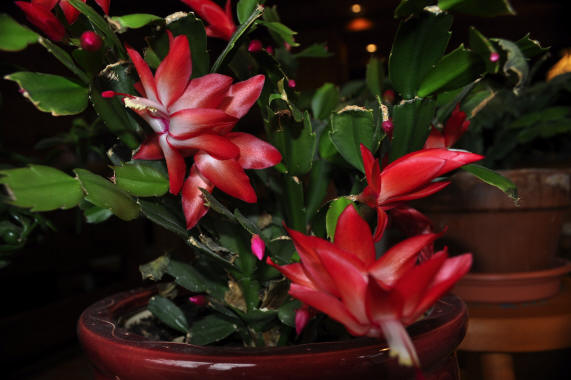Connie Holland
Adams County Master Gardener

My fondness for Christmas cactus plants comes from the numerous beautiful blooms that magically appear from green tips just as color has pretty much disappeared from my outdoor gardens. These eye candy blooms start in November, continuing well into the New Year, often blooming again in the spring.
What one thinks of as Christmas cactus is more likely to be Thanksgiving cactus since it mostly is what is sold as a holiday cactus. Plants that bloom around Thanksgiving are the species Schlumbergera truncata. True Christmas cactus blooms later into December and comes from the species Schlumbergera x buckleyi, a hybrid produced in the late 1840s
in England. In addition to bloom time, one can distinguish between the two by examining their stem segments or "leaves". Thanksgiving cactus segments have sides with pointed lobes along the edges. Christmas cactus segments are smooth sided, having no pointy edges.
Bloom form is another indicator of species difference. True Christmas cactus blooms have purplish anthers that are the pollen bearing parts of the flowers whereas the Thanksgiving cactus has yellow anthers. For the remainder of this article, Christmas cactus will refer to both species.
Bloom colors include white, pinky-white, fuchsia with a white throat, fuchsia with a fuchsia throat, red, orangey-red, apricot and yellow. For years it was my goal to collect one of each available color. I finally succeeded when I obtained a yellow-blooming plant a few years ago.

Christmas cactus species can bloom year after year. Keep them even after the holidays pass. Many are even passed down through generations. I have a true Christmas cactus that blooms a solid fuchsia color and is well over twenty-five years old.
These plants are short-day plants, meaning they flower in response to shorter days. Flowering also is related to nighttime temperatures. Ideal temperature range for flower bud development is between 55 and 60 degrees for a period of six weeks. As long as the temperatures remain in this range, plants will develop buds regardless of daylight hours.
To achieve short-daylight induced blooming, place plants in a room that does not have lamps turned on before sunrise or after sunset so they receive no more than 8-11 hours of light.
I used to force my Christmas cacti into re-blooming each year by moving them all to the basement using timer-controlled grow lights to produce the shorter light exposure. Now I just leave them upstairs by southern and western windows with no artificial lamp light exposure. Right now I have buds setting on several Thanksgiving cacti. During flower
bud formation, stop fertilizing and only water enough to keep the leaves from becoming shriveled. Sometimes my plants reward me with a few more blooms again in March or April. My personal observation is that keeping them on the dry side after flowering is a sort of rest period that, when followed by fertilization, invigorates them into blooming again. If one wishes to
force blooms anytime of the year, all that is required is to keep the plants cooler and in the dark for 13-16 hours for about four weeks.
One of the most frustrating things that can happen to Christmas cactus is that after the flower buds develop they will drop off the plant. Several different conditions, usually over-watering, insufficient light, or relocating the plant during early bud development can cause bud drop. Years ago I discovered that moving a plant led to the buds
"turning" toward the light source and then falling off! Now I leave them alone until the buds are well developed, nearly in bloom, before I relocate for viewing enjoyment.
These plants are easy to grow and are lovely just as houseplants. They are fairly disease resistant. However, since they are tropical cacti and not desert types, their needs are somewhat different. Bright indoor light intensity or outdoor shade and soil high in organic matter are recommended. Do not allow the plant to fully dry out. Water when the
soil surface begins to feel dry. The plant may be kept drier in fall. Any fertilizer may be used according to label directions. Sudden changes in temperature, light, or watering can damage the plants. Drafts and temperature extremes also can cause the flower buds to drop from the plant before they have a chance to develop.
Try to resist the temptation to repot this plant as it thrives on being pot-bound to flower. If you do repot, do not step up to a larger size and wait until the plant stops flowering. Pruning after blooming will encourage the plant to branch. Remove a few sections of each stem by pinching or cutting. These can be rooted in moist potting soil. I
have even rooted them in water to produce new plants.
These holiday plants, so common and yet so beautiful, are easy to grow and bloom every year if attention is paid to their requirements. With both Thanksgiving and Christmas approaching, why not get some?
Read other articles on house plants
Read other winter related gardening articles
Read other articles by Connie Holland